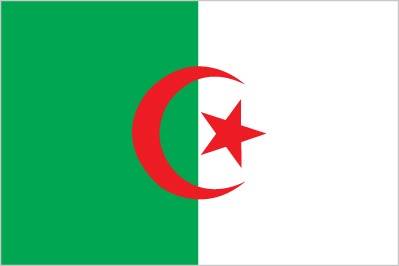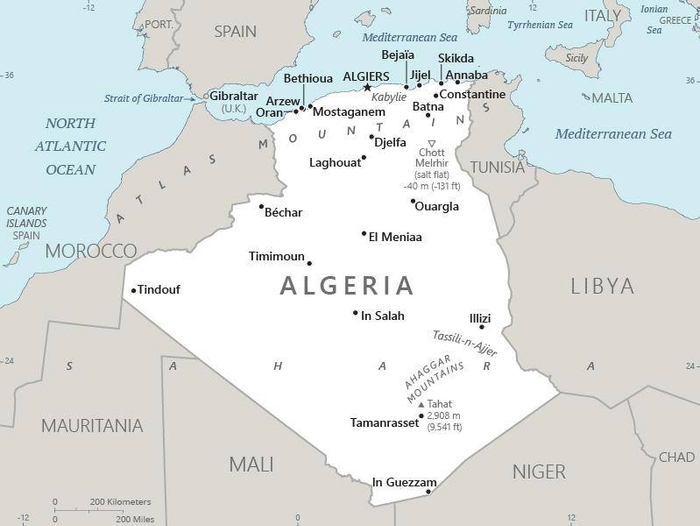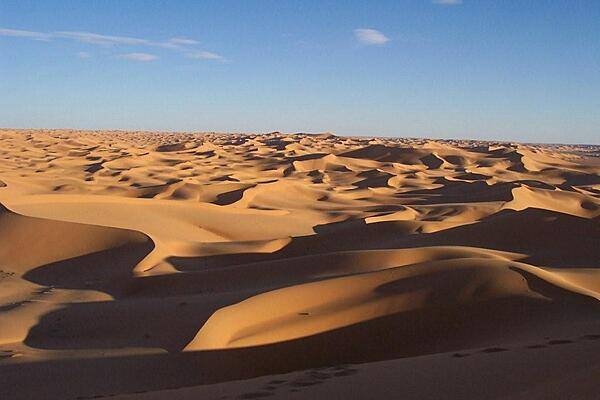177 Algeria

Two equal vertical bands of green (hoist side) and white. A red, five-pointed star within a red crescent centered over the two-color boundary. The colors represent Islam (green), purity and peace (white), and liberty (red). The crescent and star are also Islamic symbols, but the crescent is more closed than those of other Muslim countries because Algerians believe the long crescent horns bring happiness.
Flag courtesy of the CIA World Factbook

Map courtesy of the CIA World Factbook

Sahara dunes at sunset.
Photo courtesy of the CIA World Factbook
Government
According to Britannica, Algeria was dominated for the first three decades following independence by the National Liberation Front (Front de Libération Nationale; FLN), until 1989 the sole legal political party. New electoral laws passed in that year made the country a multiparty state. The current constitution, adopted in 2020, followed anti-government protests that demanded reform in the structure of the government. It made modest alterations from the constitution that was instituted in 1996, maintaining a strong executive branch but granting additional oversight to the legislature and greater independence to the judiciary.
The president, who is head of state, is elected by universal suffrage for a maximum of two five-year terms and appoints numerous state officials, including a wide range of civilian and military leaders, provincial governors, and the prime minister. The president appoints the members of the government after consultation with the prime minister, who then presents a program to the lower house of the nation’s bicameral legislature for ratification.
Once the government is in place, the head of government presents draft legislation, which is debated first in the country’s lower house, the National People’s Assembly (Majlis al-Shaʿbī al-Waṭanī), deputies of which are elected for five-year terms by universal adult suffrage. Debate then passes to the upper house, the Council of the Nation (Majlis al-Ummah), members of which serve six-year terms. One-third of council members are appointed by the president, and the remaining two-thirds are elected indirectly by a secret ballot of local and district legislatures. In addition, the constitution requires that one-half of the council’s members be replaced every three years. Both houses are able to debate any draft law put before them, but only the lower house may alter draft documents. The legislature meets for 10 months from the beginning of September through the end of June, although extended or extraordinary sessions may be called. It is empowered to draft and ratify legislation on a wide variety of issues, including matters of civil and criminal law, personal status, state finance, and the exploitation of natural resources.
Below the national level, the country is divided into wilāyāt (provinces), each with its own elected assembly (Assemblée Populaire de Wilaya; APW), executive council, and governor. The provinces are in turn divided into dawāʾir (administrative districts) and then into baladiyyāt (communes), each one having its own assembly (Assemblée Populaire Communale) to run local affairs.
The executive council of the province is the chief regional authority. It is composed of the regional directors of the state agencies that are located in the province. The council is thus responsive to both regional and national concerns. Through the provincial governor, the province exercises trusteeship and administrative control of local collectives, public establishments, independent enterprises, and national societies. As an organ of the national government, the provincial leadership participates in the planning and application of the national development plan and helps coordinate matters related to the province.
The governor is solely responsible for interaction between the national government and the province. Appointed by the president for an indeterminate term, the governor assumes any necessary function in order to coordinate relations between the national government and its local constituency. As the representative of the province, the governor presides over the implementation of the decisions of the APW, and, as a senior state functionary, the governor is the direct representative in the province of each national ministry.
At independence Algeria inherited colonial judicial institutions that were widely held by Muslim Algerians to have been established to maintain colonial authority. Judicial organization was based on two separate foundations: Muslim jurisdiction, practicing Sharīʿah (Islamic law), and French civil courts; the latter were primarily located in the larger towns where the Europeans were concentrated. Sharīʿah courts were the first, and all too frequently the final, recourse for Muslims seeking judicial redress.
Post-independence governments were quick to take steps to eliminate the French colonial judicial legacy. In 1965 the entire system was reformed by a decree that instituted a new judicial organization. This decree was followed a year later by the promulgation of new legal codes—the penal code, the code of penal procedure, and the code of civil procedure. A provincial court in each province and nearly 200 widely distributed tribunals were eventually created.
The judiciary now consists of three levels. At the first level is the tribunal, to which civil and commercial litigation is submitted and which takes action in penal cases of the first instance. At the second level is the provincial court, which consists of a three-judge panel that hears all cases and that functions as a court of appeal for the tribunals and for the administrative jurisdictions of the first instance. At the third and highest level is the Supreme Court, which is the final court of appeal and of appeals against the decisions of the lower courts. In 1975 the Court of State Security, composed of magistrates and high-ranking army officers, was created to handle cases involving state security. The constitution of 1996 introduced two new high courts to complement the Supreme Court. The Council of State acts as an administrative equivalent to the Supreme Court, hearing cases not ordinarily reviewed by that body; and the Tribunal of Conflicts was instituted to regulate any jurisdictional disputes that might arise between the other two high courts. The Constitutional Court, instituted in 2020, rules on issues of the constitutionality of treaties, negotiations, and amendments and issues opinions on the constitutionality of laws. Members of the Constitutional Court are elected or appointed by the executive, legislative, and judicial branches.
National Civil Aviation Agency
National Civil Aviation Agency
Airspace
SkyVector – Google Maps – ADS-B Exchange
ICAO countries publish an Aeronautical Information Publication (AIP). This document is divided into three parts: General (GEN), En Route (ENR) and Aerodromes (AD). ENR 1.4 details the types of airspace classes they chose to adopt from classes A through G.
Drone Regulations
Advanced Air Mobility (AAM) Regulations & Policies
None found by the author.
However, should you, the reader, happen to stumble across something to the contrary, please email the author at FISHE5CA@erau.edu and you may be mentioned in the ACKNOWLEDGEMENTS section of this book by way of thanks for contributing to this free eBook!
Advanced Air Mobility (AAM) News
None found by the author.
However, should you, the reader, happen to stumble across something to the contrary, please email the author at FISHE5CA@erau.edu and you may be mentioned in the ACKNOWLEDGEMENTS section of this book by way of thanks for contributing to this free eBook!
Short Essay Questions
Scenario-Based Question
You have been hired by a Drone Startup Company. Your boss has immediately assigned this job to you.
They need you to prepare a one-page memo detailing the legalities of using a drone to film in the Sahara, pictured above.
They need you to mention any national laws and local ordinances.
They specifically want to know what airspace (insert pictures) you will be operating in and whether or not you need an airspace authorization.
Does it matter whether or not you are a citizen of the country?
Lastly, there is a bonus for you if, as you scroll through this chapter, you find any typos or broken links!
Short Essay Questions
- What are the drone categories?
- How is registration addressed?
- How is remote ID addressed?
- What are the model aircraft rules?
- What are the commercial drone rules?
- Are there waivers or exemptions to the rules? If so, for what?
- Would you share a link to an interactive airspace map?
- How is BVLOS addressed?
- How can you fly drones at night?
- How can you fly drones over people?
- Where do you find drone NOTAMs?
- What are the rules for drone maintenance?
- What are the rules for an SMS program?
- What are some unique rules not mentioned above?
- What are the C-UAS rules?
- What are the AAM rules?

